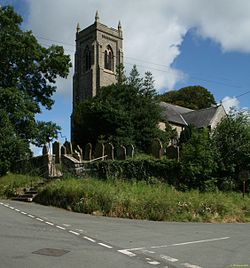Thursby
| Thursby | |
| Cumberland | |
|---|---|
 St Andrew's Church, Thursby | |
| Location | |
| Grid reference: | NY326502 |
| Location: | 54°50’31"N, 3°3’-0"W |
| Data | |
| Population: | 1,216 (2011) |
| Post town: | Wigton |
| Postcode: | CA5 |
| Dialling code: | 01228 |
| Local Government | |
| Council: | Cumberland |
| Parliamentary constituency: |
Workington |
Thursby is a village near Carlisle in Cumberland; a place of 1,216 souls according to the 2011 census.
This is a small, commuter village, standing on an old Roman road (whose route is taken by the A595), six miles south-west of Carlisle. Its name appears to be from the Old Norse Þors by after Thor, the Norse god of thunder (whose temple was reputedly at nearby Kirksteads). Today there are no such heathen implications to the village, which is set contentedly around its church.
History
The Romans once passed through Thursby on their way to Carlisle, the village's main street being their legacy. Now commuters perform the same, weary journey day by day
The parish church is a Victorian building, built in 1846 and funded by the Brisco family of Crofton Hall. The earlier chuch, which it replaced, was reportedly built by King David I of Scotland.
Sport, leisure and community
Thursby continues to thrive and grow with active community groups and regular events occurring at the parish halls as well as sports and sporting facilities (plat area at the Jubilee Field next to Thursby Primary School).
The village pub is the Ship Inn.[1][2]
Church
St Andrew's Church stands at the west end of Church Lane. Built in 1846 in Gothic revival style, it is the latest in a series of churches on the spot. The earliest church here was ssaid to have been built in about 600, and was dedicated to St Mungo. The second church on the site dated from 1124; said to have been built by David I, King of Scotland.[3]. This was demolished 1836 to make way for the church stranding today.
The current church was funded by the Brisco family and built in 1846. It underwent a restoration in 1887, at which time the pulpit was brought from Carlisle Cathedral.[4]
The church has a number of monuments dating back to before the present church was built, as well as the bells hung in the tower. It contains the Crosby Chapel, for members of that family.
The church is responsible for many organised activities from the parish council.
Sights about the village
While Thursby still largely remains a commuters' village there are still things to attract the passing visitor. There are many interesting buildings in or around the village centre (a useful map can be found at the noticeboard near the green). Traditional clay – walled buildings are a feature of Thursby, named examples include Greenwood Cottage on the green and Rosedene Cottage opposite the church on Matty Lonning. Examples of the larger Georgian farms still exist at Holly Lodge and West House in the village centre.
The more dated 17th century farmhouse at Evening Hill has elements of clay structures with outward buildings and a cart entrance found when entering south out of the village towards Curthwaite. A little further on is the Tudor-styled Evening Hill House built in 1833, with twisted candlestick chimneystacks.[5]
Outside links
| ("Wikimedia Commons" has material about Thursby) |
- Thursby on "aboutbritain"
References
- ↑ The Ship Inn
- ↑ Nikolaus Pevsner: The Buildings of England: Cumberland and Westmorland, 1967 Penguin Books
- ↑ "thursbyonline" Thursbyonline. Retrieved 27 April 2012
- ↑ Thursby St Andrew - Diocese of Carlisle
- ↑ Thursby on "aboutbritain"
